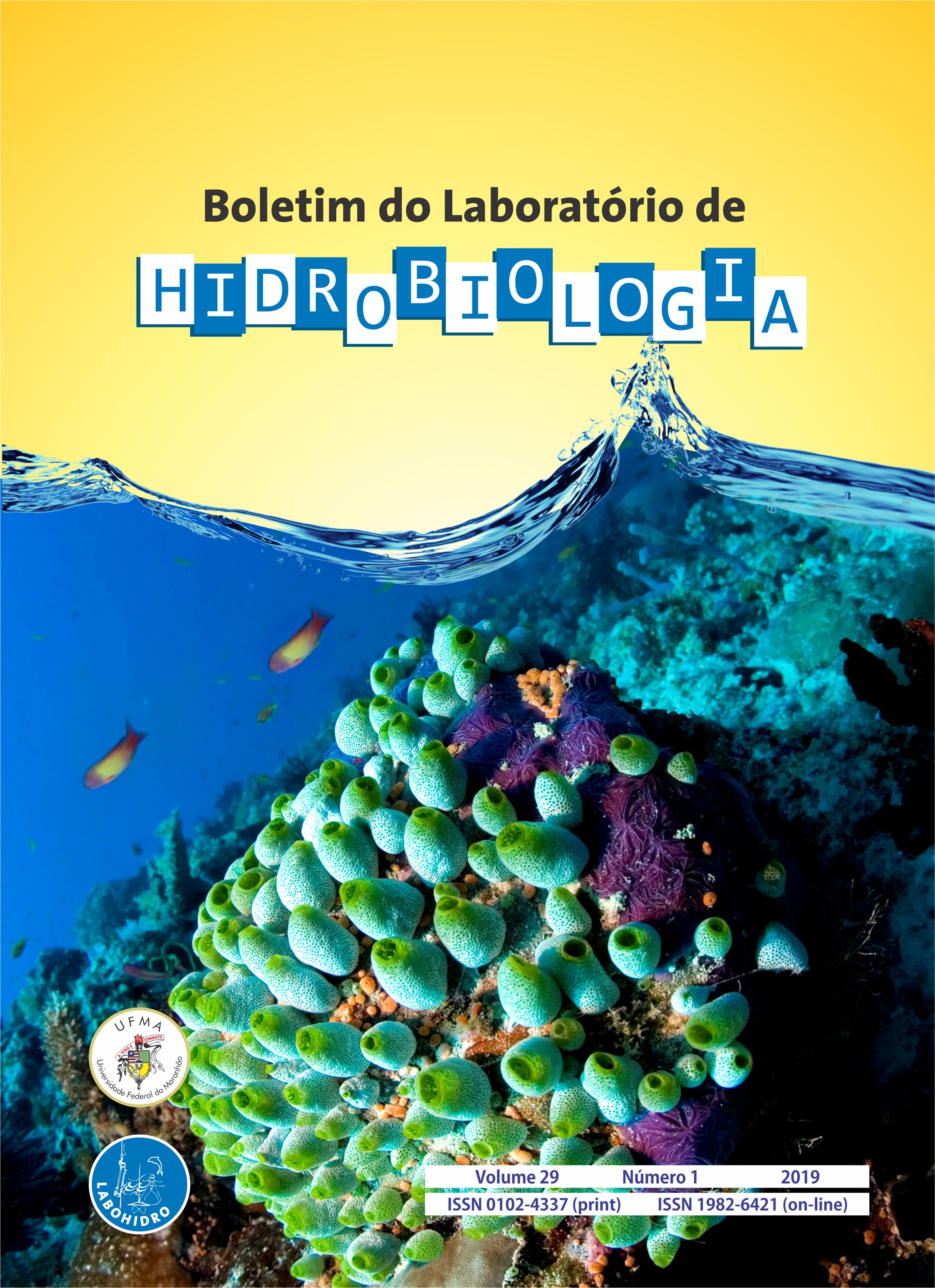A STOP FOR A SNACK: apparent humpback whale (Megaptera novaeangliae) feeding behavior and association with gillnets during migration off south-eastern Brazil
DOI:
https://doi.org/10.18764/1981-6421e2019.6Palavras-chave:
Humpback whale, Feeding areas, Entanglement, BrazilResumo
Baleias-jubarte (Megaptera novaeangliae) migram anualmente desde as águas frias dos polos, onde alimentam-se de krill e pequenos peixes, em direção a regiões tropicais e subtropicais em busca de ambientes favoráveis para reprodução e cria de filhotes. Ainda pouco conhecidos são os casos de baleias-jubarte alimentando-se em áreas de reprodução. Nesse trabalho relatamos as primeiras observações em campo de uma baleia juvenil – yearling, em provável comportamento de forrageamento buscando por prováveis crustáceos ou cefalópodes em curtos mergulhos fundos. São relatadas outras observações semelhantes nas quais das baleias pareciam aproximar-se de redes de emalhe, provavelmente atraídas por peixes ali enredados e disponíveis. Considera-se que em alguns desses casos a aproximação das baleias em direção às redes tenha causado emalhamentos, que pelo menos em um caso o exemplar libertou-se das redes. Em outros casos as redes podem ter causados ferimentos e lesões nas baleias-jubarte. Recomenda-se um acompanhamento dessas interações pela costa brasileira a longo prazo para uma melhor avaliação dessas interações.
Palavras-chave: Baleia-jubarte; Enredamento; Forrageamento; Brasil.
ABSTRACT
Humpback whales (Megaptera novaeangliae) migrate annually from the cold waters of the poles, where they feed on krill, towards subtropical and tropical regions in search of favorable environments for breeding and calving. Cases of humpback whales feeding on breeding grounds are still poorly known in the world. This study reports field observations of a juvenile whale - yearling, in Brazilian waters, with evidence of foraging behavior, in search of prey that seemed to be prawn or squid, during short dives. In addition, other similar observations are reported in southeastern Brazil in which the whales showed interest and approach gillnets, probably attracted by entangled fish. In some of these cases, it is considered that whale approaching towards the nets has caused entanglements, and in at least one case the specimen freed itself from nets. In other cases, nets may have caused humpback whale injuries. A follow-up of these interactions throughout the Brazilian coast is recommended
for a better evaluation of these interactions with fishing nets, since they may represent a new form of behavior of these whales in their migratory period.
Downloads
Referências
Alves, L.C.P.S., Andriolo, A., Zerbini, A.N., Pizzorno, J.L.A. and Clapham, P.J. 2009. Record of feeding by humpback whales (Megaptera novaeangliae) in tropical waters off Brazil. Marine Mammal Science 25(2):416-419. https://doi.org/10.1111/j.1748-7692.2008.00249.x
Baraff, L.S., Clapham, P.J., Mattila, D.K. and Bowman, R.S. 1991. Feeding behavior of a humpback whale in low latitude waters. Marine Mammal Science 7(2):197–202 https://doi.org/10.1111/j.1748-7692.1991.tb00567.x
Bortolotto, G.A., Kolesnikovas, C.K.M., Freire, A.S. and Simões-Lopes, P.C. 2016. Young humpback whale Megaptera novaeangliae feeding in Santa Catarina coastal waters, Southern Brazil, and a ship strike report. Marine Biodiversity Records, 9:29 https://doi.org/10.1186/s41200-016-0043-4
Danilewicz, D., Tavares, M., Moreno, I.B., Ott, P.H. and Trigo, C.C. 2009. Evidence of feeding by the humpback whale (Megaptera novaeangliae) in mid-latitude waters of the western South Atlantic. Marine Biodiversity Records 2:e88
https://doi.org/10.1017/S1755267209000943
Genov T., Kotnjek P. and Lipej L. 2009. New record of the humpback whale (Megaptera novaeangliae) in the Adriatic Sea. Annales, Series Historia Naturalis 19(1):25–30 http://zdjp.si/wp-content/uploads/2015/12/Tilen-Genov-Polona-Kotnjek-Lovrenc-Lipej.pdf
Hassel, L.B., Venturotti, A.C., Magalhães, F.A., Cuenca, S., Siciliano, S. and Marques, F.F.C. 2003. Summer sightings of dwarf minke whales (Balaenoptera acutorostrata) off the eastern coast of Rio de Janeiro State, Brazil. Latin American Journal of Aquatic Mammals 2, 47–50.
Jefferson T.A., Webber M.A. & Pitman R.L. 2008. Marine Mammals of the World: A Comprehensive Guide to their Identification. Academic Press, London, 573 pp. ISBN: 978-0-12-
-7
Kawamura, A., 1980. A review of food of balaenopterid whales. Scientific Reports of the Whales Research Institute, 32: 155-197.Lopes, R.M., Katsuragawa, M., Dias, J.F., Montú, M.A., Muelbert, J.H., Gorri, C. and Brandini, F.P. 2006. Zooplankton and ichthyoplankton distribution on the southern Brazilian shelf: an overview. Scientia Marina, 70: 189-202, 2006.
Papastavrou, V. and K. Van Waerebeek (1997). A note on the occurrence of humpback whale (Megaptera novaeangliae) in tropical and subtropical areas: the upwelling lin. Reports of the International Whaling Commission 47: 945-947.
Rocha, G.R.A., Rossi-Wongtschowski, C., Pires-Vanin, A.M. and Soares L.S.H. 2007. Trophic models of São Sebastião Channel and continental shelf systems, SE Brazil. Pan-american Journal of Aquatic Sciences 2: 149-162.
Salden, D.R. 1989. An observation of apparent feeding by a sub-adult humpback whale off Maui, Hawaii. Page 58 in Abstracts, Eighth Biennial Conference on the Biology of Marine Mammals. Pacific Grove, CA.
Siciliano, S. 1997. Características da população de baleias-jubarte (Megaptera novaeangliae) da costa brasileira, com especial referência aos Bancos de Abrolhos. MSc Thesis, Universidade Federal
Rural do Rio de Janeiro. 113 pp.
Silva, I.F., Kaufman, G.D., Hutsel, A., Macie, A., Maldini, D. and Rankin, R.W. 2011.
Mid-migration humpback whale feeding behavior off Eden, NSW, Australia. Document
SC/63/SH12 presented to the IWC Scientific Committee, Tromso, Norway: 11-14 July
Available at: https://iwc.int/private/downloads/bi8-UGIKIUAlm5gOkaEkNQ/SC-63-SH12.pdf
Stockin, A., and Burgess, E. A. 2005. Opportunistic feeding of an adult humpback whale (Megaptera novaeangliae) migrating along the coast of south-eastern Queensland, Australia. Aquatic Mammals 31, 120–123. DOI: 10.1578/AM.31.1.2005.120
Villegas-Zurita, F. and Castillejos-Moguel, F. 2013. Primer registro de alimentación oportunista de ballena jorobada (Megaptera novaeangliae) en la costa de Oaxaca, México. 4(1):113-119. DOI: 10.12933/therya-13-98







